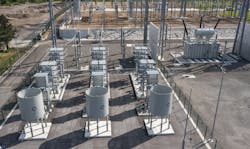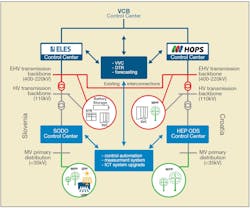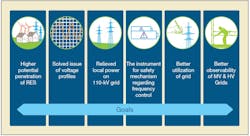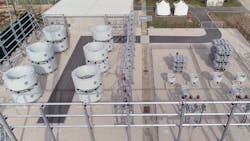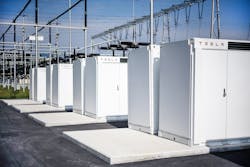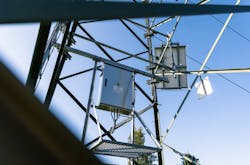Upgrading the Croatian-Slovenian Power Grid
The shared desire for a carbon-free future is changing the energy landscape as renewable energy sources (RES) are increasingly replacing fossil-fuel-generated power. However, electricity production from the majority of RES is not as stable. The electricity transmission system operator (ELES) in Slovenia and the electricity transmission system operator (HOPS) in Croatia were facing the challenges of overvoltage and lack of variable resources for voltage regulation in some parts of the networks. They identified these new challenges were due to the growing share of energy produced from dispersed RES and the increasing need for flexibility.
In some areas, the voltages were higher than the legally set operational limits (the limit is set at 10 % above the nominal voltage for the 220 kV network and 5 % above the nominal voltage for the 400 kV network). The problem resulted from a strong network, low off-peak demand, high penetration of renewables, and the inability to provide the needed reactive power using traditional approaches (generators). Overvoltage was typical in off-peak demand periods when the transmission grid was lightly loaded producing reactive power. At the same time, due to over-compensation, reactive power also came from the distribution grid to the 110 kV transmission grid. The overvoltage issue negatively impacted the lifespan of high-voltage (HV) equipment, increased the possibility of equipment failure, and, consequently, the case of outages.
Regarding the increasing need for flexibility, ELES was facing the problem of procuring an adequate amount of secondary regulation due to the increased penetration of renewables and because a thermal power plant that provided ±10 MW of secondary reserve was closed in 2014. Therefore, secondary regulation had to be provided from units in operation based on the geographical area covered by the TSO.
The variable nature of generation from RES, especially wind and PV, increased the need for secondary regulation. Unfortunately, ELES were unable to purchase the necessary capacities since there were not enough qualified generators in its geographic area. Therefore, the Slovenian and Croatian TSOs and distribution system operators (DSOs) started separately addressing these issues using classical engineering approaches and technologies. The implementation of technical measures within each of the two system control zones were studied independently, resulting in a common conclusion:
- uncoordinated actions taken in one of the two system control zones would significantly impact the other as the two system control zones are highly interconnected.
- progressive deployment of technological solutions would be less efficient since the same issues could resurface, resulting in repeated investments to maintain the operational security of the two interconnected systems.
- an uncoordinated approach would never result in a satisfactory operational security level while integrating higher amounts of RES.
The decision was taken that only joint action would create synergies and sustainably solve the problem. Therefore, in 2014, ELES and HOPS decided to find a solution together. They also teamed up with the distribution system operators in Slovenia (SODO) and Croatia (HEP ODS), initiating the first European project to introduce digitalization in the energy infrastructure – SINCRO.GRID.
Slovenia and Croatia decided to present the project to the European Commission (EC) as a proposal for a Project of Common Interest (PCI) in the field of smart grids. As a result, in 2015, the EC included the project on the PCI list. The project partners signed the contract on co-financing with the EC in 2017.
Project Objectives
The project’s key objectives were to effectively integrate electricity generation from dispersed RES generation into the existing transmission and distribution systems in Slovenia and Croatia, improve the voltage quality in both countries and increase the load transfer capacity of the existing high voltage (HV) transmission lines.
The partners decided to employ established technologies: voltage compensation devices, battery energy storage systems and the dynamic thermal rating system. In addition, a cross-border virtual control center was planned to control and regulate the voltage in both systems and thus increase the investment’s synergies and economic efficiency of the investment.
Reactive Power Compensation
The installation of compensation devices with Flexible AC Transmission Systems (FACTS) represented the most suitable response to the problem of flexibility of the sources of reactive power and the deteriorating stability of the voltage in the network due to the reduced share of conventional production because of the increasing integration of RES. All the analyses clearly showed that the only option would be installing compensation devices — either shunt reactors or more advanced technologies such as SVC and STATCOM devices.
The analysis of different configurations of compensation devices (considering the balanced distribution of costs between the two system operators) showed that the issue could be optimally solved by installing + 250/-450 Mvar of compensation devices in Slovenia and +40 /- 550 Mvar in Croatia.
ELES and HOPS installed seven compensation devices, four variable shunt reactors, two static VAR compensators, and a mechanically switched capacitor with a damping network.
In Slovenia, ELES installed:
- Static synchronous compensator (STATCOM) rated at +/- 150 Mvar in 400/220/110 kV in Beričevo substation.
- Variable shunt reactor rated at –150 Mvar and a mechanically switched capacitor with a damping network and capability of + 100 Mvar in 400/110-220/110/35/10 kV Divača substation.
- Variable shunt reactor rated at –150 Mvar in 400/220/110 kV Cirkovce substation.
In Croatia, HOPS installed three devices:
- Variable shunt reactor rated –100 Mvar at the 220/110/10 kV Mraclin substation.
- Variable shunt reactor rated at –200 Mvar at the 400/220/110 kV Melina substation.
- Stationary compensation device with static VAR compensation SVC technology rated at –250 Mvar at the 400/220/110 kV Konjsko substation.
Installation of these devices and the implemented virtual cross-border control center (VCBCC) with the advanced algorithms for Volt VAR Control (VVC) optimization to maintain acceptable voltages and the reduction of system losses achieved the goal of voltage profile control and the possibility of voltage regulation in the electricity systems of both Slovenia and Croatia. Furthermore, this innovation by ELES and HOPS also introduced an entirely new form of joint voltage regulation of both transmission systems. As a result, these compensation devices have contributed to improving network stability during emergencies. Moreover, their operation’s effects have already positively impacted the transmission systems of neighboring countries.
Battery Systems
Two battery energy storage systems (BESS) based on lithium-ion cells were installed in Slovenia to increase the flexibility of active power and, thus, the reliability of the system operation. BESS will also facilitate the transition to future electricity systems where the production of electricity from dispersed renewables and the active participation of prosumers in the energy market will prevail.
The battery energy storage systems are divided into two 5 MW units installed in Slovenia in the existing 110/35 kV Pekre and 400/110 kV Okroglo substations. They have a total active power of 10 MW and a nominal capacity of 50 MWh, ranking these BESS installations among the largest installed in Europe. Therefore, including these systems in the operation of ELES provides a powerful tool for addressing modern challenges in the electricity system — not only in Slovenia but in the broader region
Dynamic Line Rating
Power lines traditionally have a pre-set thermal power rating that enables the safe operation of the transmission grid. This thermal rating has a fixed value and should allow for safe operation in all weather conditions and loading of the lines. However, the actual thermal rating is highly affected by local weather conditions (outside temperature, loading of the line, wind, etc.) and is usually higher than the pre-set rating. Advanced smart grid solutions allow real-time monitoring of local conditions on the lines, thus enabling better grid use. Increasing the transfer capacities with overhead line dynamic thermal ratings (DTR) is a smart grid technology deployed within the SINCRO.GRID project.
In Slovenia, ELES deployed a DTR system to allow real-time monitoring of local conditions on the overhead lines (OHL) and thus enable better and safer grid use. 31 weather stations were installed on ten power lines having the approximate length of 243 km (151 miles). Weather measurements were included in the weather processing system ONAP (Atmospheric Conditions Forecast Assessment) and augmented gridded weather data used in dynamic line rating (DLR). In Croatia, HOPS deployed the DTR on the three 220 kV lines (around 162 miles of lines) are covered with system and weather stations are installed on 15 towers.
Dynamic line rating (DLR) algorithms and models for the DLR system within these weather stations calculate the dynamic thermal limits of transmission lines for operation, thereby increasing the accuracy in terms of circuit loading of the real-time and short-term load forecasts. In addition, data from these weather stations improved the mesoscale weather data obtained from the Slovenian Environment Agency, thus reducing any uncertainties in calculations. The SUMO DLR system installed is entirely the result of Slovenian knowledge. ELES managed to attract leading Slovenian experts to participate in its development.
ELES and HOPS now use the results to improve the safety of operation and the transmission capacity of the network; hence, the existing infrastructure is used more efficiently. Furthermore, with the average 15% to 20% increase in transmission capacities, it is now also possible to transfer larger quantities of energy from renewable sources in southern Croatia to the energy markets in the region.
Virtual Cross-Border Control Center
ELES – HOPS Virtual Cross-border Control Center (VCBCC) was set up for coordinated and controlled centralized representation of RES production and system variables of the Slovenian and Croatian HV and MV networks to allow power system optimization in the whole control area. The VCBCC consists of numerous IT solutions that enable data acquisition from renewable energy sources providing improved observability of energy networks and more accurate estimation/forecasting of renewable energy sources production. This is the first case in Europe where neighboring transmission system operators have joined forces in regulating and optimizing the voltage in their transmission systems.
Additionally, advanced solutions were implemented at the control center. These include an IT platform for
- the integration of prosumers in ancillary services; a communication platform for operational data exchange between transmission and distribution system operators
- an upgrade of the metering system to support modern data exchange based on the latest standards
- an upgrade of the solar production forecasting tool and modernization of the ICT infrastructure.
Project Profile
The partners in the project, namely ELES, SODO (Slovenia), HOPS and HEP ODS (Croatia), combined various traditional and new approaches in this smart grid project that included investments in infrastructure, technologies and processes.
The project extended over five years, from November 2016 to November 2021. The total investment cost of the project was valued at € 88.6 million ($US80.2) of which the European Commission (CEF fund) co-financed € 42.1 million ($US 40.9).
The SINCRO.GRID project demonstrated how distribution and transmission system operators could enable their existing infrastructure to accept more significant quantities of electricity from renewable sources while ensuring a reliable electricity supply.
Simon Tot ([email protected]) MSc, is the assistant director of Strategic Innovation Department, ELES, with over 37 years of experience in the energy sector.. He has been working at ELES for the last five years. Tot’s main tasks are the development of smart grids with an emphasis on the flexibility of active and reactive power in the Slovenian transmission network and how to prepare the transmission network for the inclusion of increased amounts of renewable energy sources.
Nadja Novak ([email protected]) MMSc. is a public relations specialist, ELES, with over 18 years of experience in public relations. She has been working at ELES for more than seven years. Her main tasks are planning and implementing the communication and dissemination activities for the EU-funded and other strategic innovation projects and activities.
Mate LasiĆ ([email protected]) MSc, is head of development, HOPS, with over 19 years of experience in the energy sector. He has been working at HOPS for the last ten years. His main tasks are the development of Croatian transmission network and preparing smart grids projects with an emphasis on the flexibility of active and reactive power in the Croatian transmission network.
About the Author
Simon Tot
Simon Tot ([email protected]) has over 37 years of experience in the energy sector as is the Assistant Director of Strategic Innovation Department, ELES, d.o.o.. He has been working at ELES for the last five years. Tot’s main tasks are the development of smart grids with an emphasis on the flexibility of active and reactive power in the Slovenian transmission network and how to prepare the transmission network for the inclusion of increased amounts of renewable energy sources.
Nadja Novak
Nadja Novak ([email protected]) MSc. is a public relations specialist, ELES, d.o.o. who has over 18 years of experience in public relations. She has been working at ELES for more than seven years. Her main tasks are planning and implementing the communication and dissemination activities for the EU-funded and other strategic innovation projects and activities.
Mate Lasić
Mate Lasić ([email protected]) MSc, is head of development, HOPS, with over 19 years of experience in the energy sector. He has been working at HOPS for the last ten years. His main tasks are the development of Croatian transmission network and preparing smart grids projects with an emphasis on the flexibility of active and reactive power in the Croatian transmission network.

